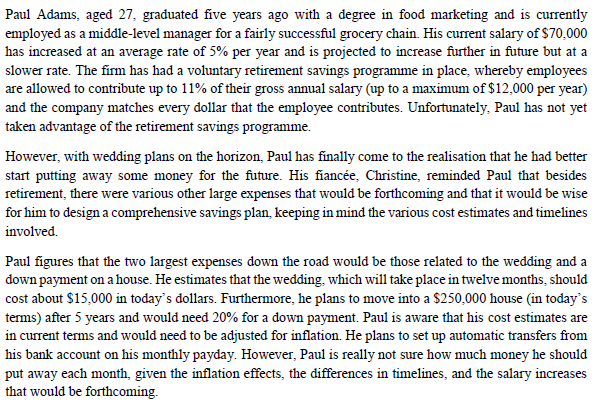

Paul Adams, aged 27, graduated five years ago with a degree in food marketing and is currently employed as a middle-level manager for a fairly successful grocery chain. His current salary of $70,000 has increased at an average rate of 5% per year and is projected to increase further in future but at a slower rate. The firm has had a voluntary retirement savings programme in place, whereby employees are allowed to contribute up to 11% of their gross annual salary (up to a maximum of $12,000 per year) and the company matches every dollar that the employee contributes. Unfortunately, Paul has not yet taken advantage of the retirement savings programme. However, with wedding plans on the horizon, Paul has finally come to the realisation that he had better start putting away some money for the future. His fiance, Christine, reminded Paul that besides retirement, there were various other large expenses that would be forthcoming and that it would be wise for him to design a comprehensive savings plan, keeping in mind the various cost estimates and timelines involved Paul figures that the two largest expenses down the road would be those related to the wedding and a down payment on a house. He estimates that the wedding, which will take place in twelve months, should cost about $15,000 in today's dollars. Furthermore, he plans to move into a $250,000 house (in today's terms) after 5 years and would need 20% for a down payment. Paul is aware that his cost estimates are in current terms and would need to be adjusted for inflation. He plans to set up automatic transfers from his bank account on his monthly payday. However, Paul is really not sure how much money he should put away each month, given the inflation effects, the differences in timelines, and the salary increases that would be forthcoming. a) What was Paul's starting salary? How much could he have contributed to the voluntary savings plan in his first year of employment? (3 marks) b) If Paul had taken advantage of the company's retirement programme up to the maximum, every year for the past five years, how much money would he currently have accumulated in his retirement account, assuming a nominal rate of return of 7%? To get a rough estimate assume he made the payments into the retirement account once per year at the end of each calendar year. (6 marks) c) If Paul starts his retirement savings plan from January of next year by contributing the maximum allowable amount into the firm's retirement savings programme, how much money will he have accumulated for retirement, assuming he retires at age 65 and the rate of return on the account is 7% per year, compounded monthly, and that the maximum allowable contribution does not change? While he is not sure about his future salary increases, he reckons that his salary will average around $95,000 for the rest of his career. (6 marks)








